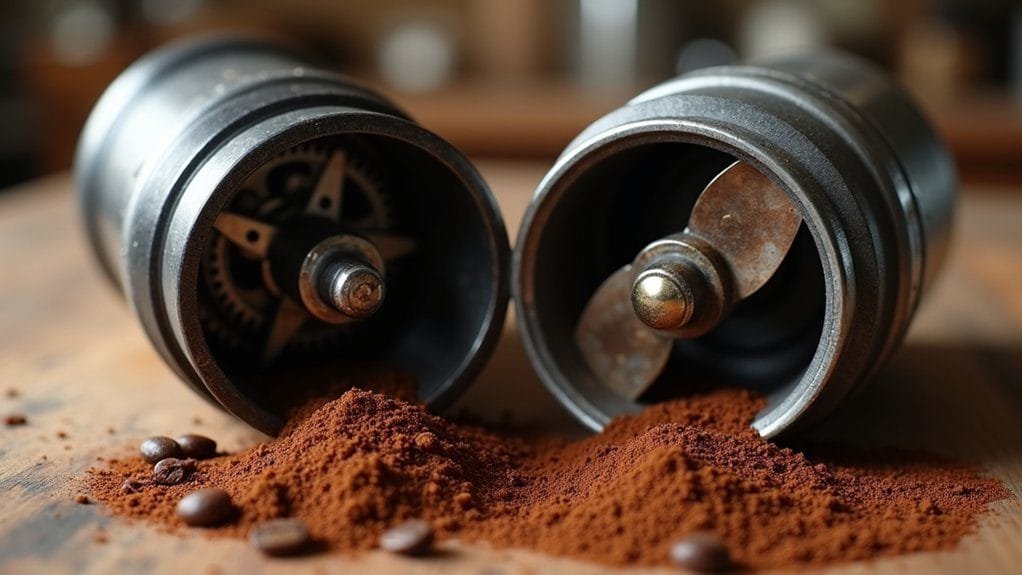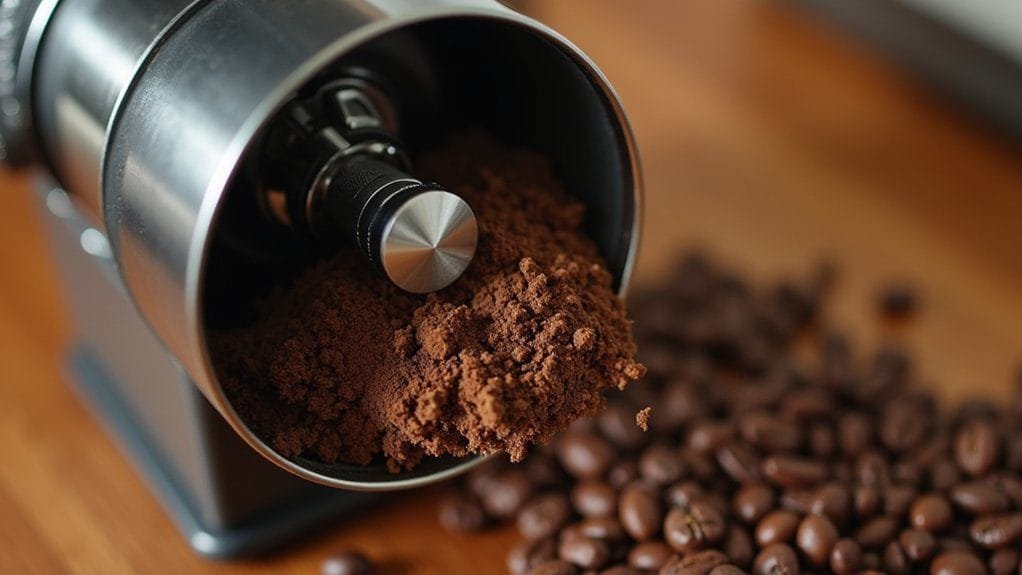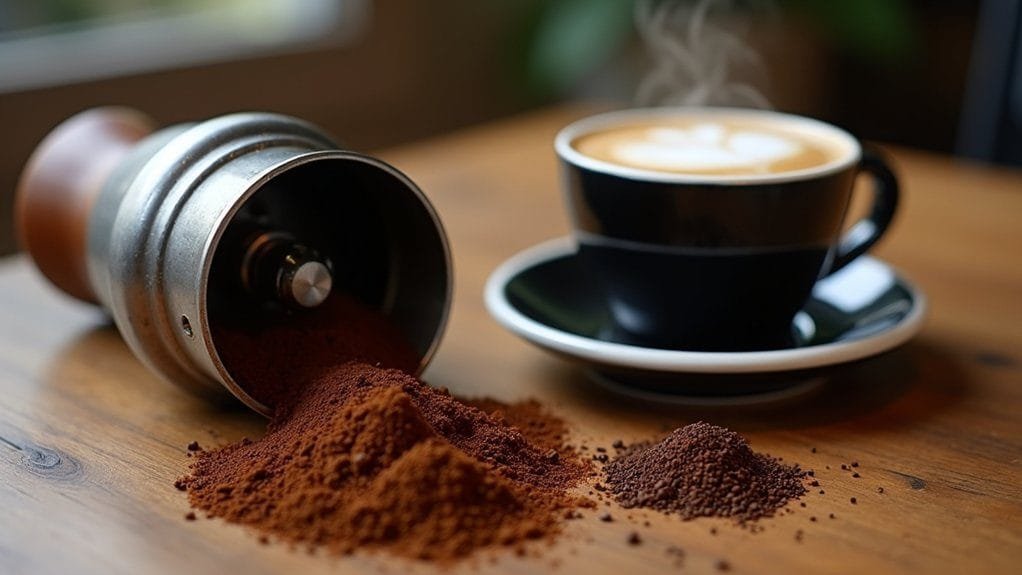When comparing burr and blade coffee grinders, burr grinders consistently outperform blade grinders in grind quality. They use two revolving surfaces to crush beans, resulting in a uniform grind size that enhances flavor extraction and minimizes bitterness. In contrast, blade grinders chop beans unevenly, leading to inconsistent particle sizes and undesirable flavors. The precision of burr grinders allows you to tailor the grind to your preferred brewing method, yielding superior taste. Explore further to understand the nuances of each grinder type.
Key Takeaways
- Burr grinders provide consistent grind sizes, enhancing flavor extraction and minimizing bitterness, making them superior for coffee quality.
- Blade grinders create uneven particle sizes, which can lead to under-extraction and undesirable flavors in brewed coffee.
- Burr grinders minimize heat generation, preserving essential oils and the coffee’s overall aroma and flavor profile.
- Conical and flat burr grinders offer tailored options for different brewing methods, while blade grinders lack this precision.
- Regular maintenance of burr grinders ensures optimal performance, while blade grinders often require less upkeep but compromise on grind quality.
Understanding Coffee Grinding


When you grind coffee, the grind size plays a significant role in the brewing process, influencing both extraction rates and flavor profiles. Burr grinders excel in this aspect, utilizing two revolving surfaces to produce a consistent grind, vital for ideal flavor extraction. In contrast, blade grinders chop beans unevenly, leading to inconsistent coffee grounds that can result in undesirable flavors. The choice of grind size must align with your brewing method; coarser grinds work well for French press, while finer grinds are necessary for espresso. Additionally, burr grinders, specifically conical and flat burr types, minimize heat generation during grinding, preserving the coffee’s natural oils and preventing bitterness. Regular maintenance is essential for burr grinders to guarantee the best performance and taste.
The Mechanics of Burr Grinders
Burr grinders stand out in coffee grinding technology due to their unique mechanics, which greatly enhance the grinding process. They utilize two revolving abrasive surfaces, or burrs, to crush coffee beans, allowing you to adjust grind sizes for various brewing methods. Conical burr grinders, featuring a cone-shaped central burr, provide a gravity feed that promotes a consistent grind with minimal noise. In contrast, flat burr grinders align horizontally, delivering precision for uniform grind sizes, ideal for espresso. Importantly, burr grinders minimize heat generation during grinding, preserving the coffee’s flavor and aroma while reducing bitterness. Regular maintenance, including cleaning the burrs, can markedly extend the lifespan and performance, with some burrs rated for up to 500 pounds of coffee.
The Mechanics of Blade Grinders


While burr grinders excel in delivering consistent grind sizes, blade grinders operate quite differently by utilizing a rotating blade mechanism to chop coffee beans. This method results in inconsistent particle sizes, hindering flavor balance and often leading to bitterness in your brew. To help mitigate these issues, users are advised to pulse the grinder instead of grinding continuously, which can also help minimize heat generation that negatively affects the coffee oils.
| Feature | Blade Grinders | Impact on Brew |
|---|---|---|
| Particle Sizes | Varies from fine to coarse | Inconsistent extraction |
| Heat Generation | Higher due to continuous use | Can alter flavor negatively |
| Control Over Grind | Low | Lacks precision |
Comparing Grind Consistency
To achieve the best flavor extraction from your coffee, understanding grind consistency is essential. Burr grinders excel in this area, providing uniform grinds that guarantee even extraction. Here’s how they compare to blade grinders:
- Precision Cutting: Burr grinders utilize two revolving burrs, allowing tailored grind adjustments for various brewing methods.
- Particle Size Control: They minimize ultra-fine particles, reducing the risk of bitter flavors.
- Uniformity: Flat burr grinders create more consistent grinds, while conical burr grinders offer affordability with minimal quality compromise.
- Inconsistent Extraction: Blade grinders chop coffee beans unevenly, resulting in mixed particle sizes, which can lead to inconsistent extraction and variable flavor profiles.
The Impact on Coffee Flavor


When you choose a burr grinder over a blade grinder, you’re not just opting for a different method of grinding; you’re fundamentally altering the flavor profile of your coffee. Burr grinders produce a consistent grind size, which enhances flavor extraction and minimizes bitterness, resulting in a balanced cup. In contrast, blade grinders create uneven particles, leading to both under-extraction and over-extraction during brewing. This imbalance can result in undesirable sour and bitter notes, detracting from the intended coffee flavor. Additionally, burr grinders operate at lower temperatures, preserving essential oils and flavors. With precise control over grind size, you can tailor your coffee to specific brewing methods, ultimately achieving a superior flavor profile and aroma that blade grinders simply can’t match.
Types of Burr Grinders Explained
Understanding the types of burr grinders is essential for anyone serious about coffee. The two main types, conical and flat burr grinders, each have unique benefits that cater to different preferences.
- Conical Burr Grinders: These grinders feature a cone-shaped burr and are generally more affordable, easier to calibrate, and versatile for various brewing methods, although they may produce slightly uneven grounds.
- Flat Burr Grinders: With two horizontally aligned burrs, they provide superior grind consistency and flavor clarity, making them a favorite among coffee lovers, especially for espresso preparation.
- Manual Burr Grinders: They offer greater control over grind settings, allowing enthusiasts to fine-tune their grind.
- Electric Burr Grinders: These are convenient and fast, perfect for those who prioritize efficiency.
Choosing the right type depends on your brewing needs.
Choosing the Right Grinder for Your Needs
How do you determine the right coffee grinder for your needs? If you value consistency and ideal flavor extraction, a burr grinder is your best option. Its ability to produce uniform grind sizes enhances brew quality across various methods. For casual drinkers on a budget, a blade grinder might suffice, but be aware that it compromises grind quality, often resulting in bitter coffee due to uneven particles. Serious coffee enthusiasts should invest in a burr grinder, particularly a conical burr for versatility or a flat burr for espresso clarity. Consider your brewing method and maintenance preferences; while burr grinders require more upkeep, their longevity and superior grind consistency make them worthwhile for regular coffee drinkers.
Expert Recommendations and Insights
While many coffee drinkers might overlook the importance of a good grinder, experts unanimously agree that investing in a quality burr grinder greatly elevates your coffee experience. Here are four key insights:
- Grind Consistency: Burr grinders, especially with flat or conical burrs, guarantee uniform particle sizes, enhancing flavor extraction.
- Recommended Models: The Baratza Virtuoso+ and Baratza Sette 270 are top choices for their precision in grind size.
- Affordability vs. Precision: Conical burr grinders are often more affordable, while flat burr grinders excel in flavor clarity.
- Longevity: With proper maintenance, burr grinders can last 8-10 years, unlike less durable blade grinders.
For coffee enthusiasts, these factors highlight the importance of choosing a high-quality burr grinder for superior coffee.
Frequently Asked Questions
Is a Burr Grinder Really Better Than a Blade Grinder?
Yes, a burr grinder’s grind consistency enhances flavor extraction across brewing methods. It offers adjustable grind settings for improved coffee freshness, though it may require more maintenance and comes at a higher price compared to blade grinders.
Does Coffee Taste Better With a Burr Grinder?
When it comes to coffee, think of grind consistency as the key to revealing your flavor profile. A burr grinder enhances aroma, improves extraction efficiency, and adapts to various brewing methods, ensuring noticeable taste differences in your coffee beans.
What Is the Advantage of a Burr Coffee Grinder?
A burr grinder offers significant benefits, including grind consistency and uniform particle size. Its adjustable settings enhance flavor extraction for various brewing methods. Plus, it’s durable and easier to maintain, justifying its price range for serious coffee enthusiasts.
Do I Really Need a Burr Coffee Grinder?
With burr grinders lasting up to 10 years, you’ll appreciate the grind consistency they provide. Unlike blade grinders, they enhance coffee flavor differences across brewing methods, justifying the price comparison despite higher initial costs and maintenance requirements.
Which Cordless Drill is Best for Grinding Coffee Between DeWalt and Makita?
When it comes to choosing between brands for grinding coffee, a “dewalt or makita cordless drill comparison” reveals key differences. DeWalt offers robust power and durability, ideal for heavy tasks, while Makita is known for its precision and lighter weight, making it a strong contender for coffee enthusiasts.
Conclusion
To sum up, when it comes to coffee grinding, burr grinders generally outperform blade grinders in consistency and flavor extraction. Research shows that burr grinders can produce grinds with a uniformity of up to 90%, compared to blade grinders, which often yield inconsistent particle sizes. This variation can greatly impact your coffee’s taste, leading to a more balanced and richer cup. By understanding these differences, you can make an informed choice that elevates your coffee experience.
